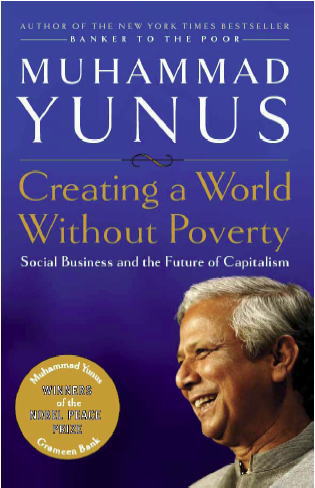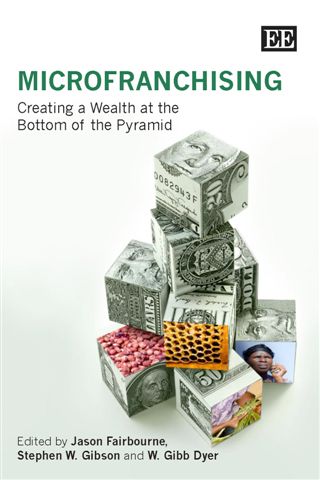
Starting with an update on microfinance, it covers other innovative market-oriented models such as base of the pyramid (BOP) businesses, social enterprises and microfranchises. These models together with microfinance are improving the lives of the 4 billion people living at the BOP. The last section covers in detail a remarkable example in this area, Scojo Foundation. Scojo is developing the market for affordable reading glasses at the BOP through microfranchising.The book provides the author’s insights on 1) how the business (for-profit) and social (non-profit) worlds have been converging, setting the stage for these new models to emerge, 2) how these models, the people behind them, and the advent of Web 2.0, are creating a strong and positive movement towards a more responsible, sustainable and kinder world and 3) how all of us could make a difference.The book has been published in German language by rueffer and rub with the title >Kleiner Einsatz Grosse Wirkung. (Small input, big impact – thus,the red chilis of the cover) This book illustrates a giga trend, the powerful movement of making the world a better place.
Category Archives: empowering people
2008 Skoll Forum Highlights
The 5th Skoll World Forum for Social Entrepreneurship took place last week in Oxford. This powerful, inspiring forum led by Jeff Skoll and Sally Osberg celebrates and connects social entrepreneurs to the world and is making “social entrepreneurship” known to governments as well as businesses. This year’s highlights were the speeches of Lord Anthony Giddens (climate change: opening plenary) former President Jimmy Carter (keynote: Skoll Awards Ceremony) and Paul Farmer and Al Gore (both in the closing plenary). There were 11 Skoll Awards given out this year and Kiva (Matt Flannery and Permal Shah) was one of them. This was the second year in the row that I attended Skoll Forum and it is an awesome experience to be 3 days in a place where you see over 700 people trying to make a world a better place. One of the ventures that I was very impressed about is E+Co which empowers local enterprises in developing countries by providing business services and financing so that these enterprises can deliver clean and affordable energy to households, businesses and communities. There are several sessions that are covered by video and are all highly recommended.
Goldman Sachs to invest in business/management education of 10,000 women
Goldman Sachs launched last week 10,000 WOMEN, an amazing initiative that will deliver business and management education to 10,000 underserved women predominantly in developing and emerging markets. Goldman Sachs will commit $100 million over the next 5 years (in addition to the time and expertise that the GS people will be dedicating on mentoring) to this initiative supporting partnerships between universities in the U.S. and Europe and business schools in emerging and developing economies. The initial partnerships are working on pragmatic, flexible and short term programs resulting in business and management certificates. Brown,Columbia, Harvard, Stanford, Cambridge, University of Michigan, and Wharton have already initiated academic partnerships with business schools in Africa and the Middle East for this program.
The initiative has two goals: increasing the number of underserved women receiving a business/management education and improving the quality and capacity of business/management education around the world. Expanding the entrepreneurial talent and managerial pool in developing and emerging economies -especially among women- is one of the most important means to reducing enequality and ensuring more shared economic growth. (Executive Summary)
It is a remarkable initiative addressing effectively one of the most difficult obstacles for sustainable economic growth. The initiative will provide many microentrepreneurs with the much needed business/management skills that would enable them to build and expand their businesses and thus, contribute significantly to the economic growth of their countries.
10,000 Women Fact Sheet
Press release
Book:Creating a World Without Poverty: Social Business and the Future of Capitalism by Yunus Muhammad
 Muhammad Yunus, Nobel Peace Price winner, in his continuing fight to make poverty history promotes a new type of enterprise which has as its objective to make a difference. These social business enterprises will be self sustainable, in his words “no loss, no dividend enterprises”. He refers to two types of such enterprises one having investors like the latest joint venture between Grameen and Danone, an enterprise providing fortified yoghurt to malnourished children. Investors will get their capital back, but, profits will be injected back to the company to continue to achieve its objective. The second type of social business enterprise is a for-profit model but owned by the poor such as Grameen Bank.This book goes in depth explaining his “Next Big Idea” social businesses and also present some ideas on how corporations and individuals can take part in achieving a “world without poverty”. It is inspirational and of course uplifting. Highly recommended. Past related entry on this topic, “Muhammad Yunus promotes social businesses”http://www.microfinance.ws/microfinance/2006/12/
Muhammad Yunus, Nobel Peace Price winner, in his continuing fight to make poverty history promotes a new type of enterprise which has as its objective to make a difference. These social business enterprises will be self sustainable, in his words “no loss, no dividend enterprises”. He refers to two types of such enterprises one having investors like the latest joint venture between Grameen and Danone, an enterprise providing fortified yoghurt to malnourished children. Investors will get their capital back, but, profits will be injected back to the company to continue to achieve its objective. The second type of social business enterprise is a for-profit model but owned by the poor such as Grameen Bank.This book goes in depth explaining his “Next Big Idea” social businesses and also present some ideas on how corporations and individuals can take part in achieving a “world without poverty”. It is inspirational and of course uplifting. Highly recommended. Past related entry on this topic, “Muhammad Yunus promotes social businesses”http://www.microfinance.ws/microfinance/2006/12/
Bill Gates Calls for “Creative Capitalism”
On January 24th at the WEF in Davos, Bill Gates made a call on “creative capitalism” a new system that “would have a twin mission: making profits and also improving lives for those who don’t fully benefit from market forces.” He pointed out that “To make the system sustainable, we need to use profit incentives whenever we can. At the same time, profits are not always possible when business tries to serve the very poor. In such cases there needs to be another market incentive- and that incentive is recognition… In markets where profits are not possible, recognition is a proxy; where profits are possible, recognition is an added incentive.The challenge is to design a system where market incentives including profits and recognition, drive the change” He cited examples like Bono’s RED Campaign which has generated in 18 months $50mn for the Global Fund to Fitght AIDS TB and Malaria, a Dutch company which holds the rights to a cholera vaccine that retains the rights in the developed world but shares those rights with manufacturers in the developing world, and a new law in the USA whereby drug companies that develop a new treatment for a neglected disease like malaria or TB can get a priority review from the FDA for another product they have made. He called on businesses, governments and the non-profit world on to take up on projects that works both to generate profit and solve the world’s inequities.
This is a great call on what is also referred as BOP businesses and “double or triple bottom line businesses” and the work done by many social entrepreneurs. The new name is good and easy to understand. The best part is the potential impact of this call as it comes from one of the most powerful business leaders and one of the most influential philanthropist of today. The webcast of this speech is available from the WEF site.
Topics for 2008: Mobile Banking at the BOP
An exciting area of growth is mobile banking as it is accelerating the outreach of financial services at the BOP. The increasing use and diffusion rate of mobile telephony in developing countries is creating low cost alternatives for people to make deposits, remittances and payments. Smart Money and Globe’s G-Cash in the Philippines, Wizzit in South Africa and M-Pesa in Kenya are some of the innovative mobile transaction systems. Africa has witnessed a spectacular growth in mobile phone subscriptions from 15.3mn in 2000 to 198mn in 2006. The penetration rate in this period soared from 1.97% in 2000 to 21.48% in 2006! (Penetration rate of fixed lines in the same period went from 2.48% to 3.09%). CGAP is covering this area with a slightly broader scope. They have published very interesting notes on “branchless banking” which they define as “the delivery of financial services outside conventional bank branches using information and communications technologies and non-bank retail agents (merchants, supermarkets, post offices)”. The notes published so far cover India, Kenya and Pakistan. Mobile banking/branchless banking is a hot topic for 2008.
MicroPlace, an ebay company launches a Microfinance Investment Website for the retail investor
On October 24th, MicroPlace launched its web site that allows people to invest as little as $100 in microfinance. More precisely, people can purchase investment notes with returns ranging from 1.5 to 3.0% that are issued to a particular microfinance institution. This is great news as this provides another option for people to participate in supporting microentrepreneurs worldwide. So now in addition to Kiva which allows people to support microentrepreneurs with a loan (you get capital back but no interest) you have MicroPlace where you can make money from these loans “doing good, doing well”. This news has been covered by Businessweek, Reuters, Fortune etc but the best article out is by Rob Katz of nextbillion titled “Kiva vs. MicroPlace-What is the difference?” an excellent read. Kudos for Calvert Foundation, which is the first issuer for MicroPlace. Calvert has been offering for the past 10 years community investment notes including those that went to fund microfinance institutions and these notes were offered to the public at large. One of the very few choices that have existed but now their efforts can be inmensely scaled!
One request to MicroPlace/ebay and to the microfinance investment community. Kiva is a non-profit so everyone can participate but investments in MicroPlace is only available for US investors (US residents). I am aware of the constraints in the investment world but can we/someone make a platform or several platforms for investments so that everyone can invest?
The Elders- a Group of World Leaders for Humanity
On July 18th, Nelson Mandela launched the Global Elders, a group of leaders that will contribute their wisdom, independent leadership and integrity to tackle some of the world toughest problems. The founding members of this group are Desmond Tutu, Graça Machel, Koffi Annan, Jimmy Carter, Li Zhaoxing, Mary Robinson, Muhammad Yunus, Ela Bhatt and Gro Harlem Brundtland. The Elders was an idea conceived by Richard Branson and Peter Gabriel. In a recent article of Businessweek, Richard Branson explains “Peter Gabriel and I started a journey with Nelson Mandela several years back when we felt the world was rapidly becoming a global village, yet we had no advisers who were driven by what ‘s best for humanity rather than what’s best for the military, the economy, or a political group.We hope this group will become the elders of our global village and play a role in alleviating human suffering.” Mandela in his speech said “The Elders can speak freely and boldly, working both publicly and behind the scenes on whatever actions need to be taken. Together we will work to support courage where there is fear, foster agreement where there is conflict and inspire hope where there is despair.”
It is an impressive group of doers and also backed by powerful entrepreneurs. We are living in an unprecedented point in time when huge problems can be tackled and solved as there is the willingness, the funds, the ideas and the people that can do it. If you want to share your thoughts on the role of the Global Elders click here.
The book “MicroFranchising”
 MICROFRANCHISING: Creating Wealth at the Bottom of the Pyramid, the first major publication on this subject, is now available. (Edward Elgar Publishing). This edited volume comprising 13 chapters and 18 authors introduces the concept of microfranchising and discusses how this business model can be effectively used for poverty alleviation. Different models of microfranchising are reviewed and specific case studies are highlighted to show how it has worked and is working in different parts of the world. Also the advantages as well as potential problems and pitfalls of microfranchising are discussed. My contribution was on the subject of “Microfranchise Funding” (Chapter 12).
MICROFRANCHISING: Creating Wealth at the Bottom of the Pyramid, the first major publication on this subject, is now available. (Edward Elgar Publishing). This edited volume comprising 13 chapters and 18 authors introduces the concept of microfranchising and discusses how this business model can be effectively used for poverty alleviation. Different models of microfranchising are reviewed and specific case studies are highlighted to show how it has worked and is working in different parts of the world. Also the advantages as well as potential problems and pitfalls of microfranchising are discussed. My contribution was on the subject of “Microfranchise Funding” (Chapter 12).
If there is one thing I could hope for is that the price for this book would be a bit lower so more people can afford to buy it and read it.
“The Next 4 Billion” BOP market report by WRI
The Next 4 Billion: Market Size and Business Strategy at the Base of the Pyramid is a timely and valuable contribution by the team of WRI (Allen L. Hammond, William J. Kramer, Robert S. Katz, Julia T. Tran, Courtland Walker). This reports gives a detailed economic portrait of the BOP based on recorded incomes and expenditures and an overview of sector-specific business strategies from successful enterprises operating in the BOP markets. It is full of data and information that is needed for the private sector which is currently increasing its engagement to this large segment.
